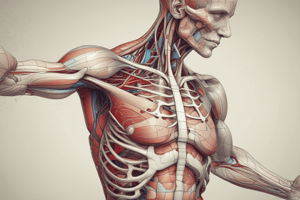Podcast
Questions and Answers
What are the two main components of the nervous system?
What are the two main components of the nervous system?
- Kidneys and liver
- Brain and spinal cord (correct)
- Lungs and heart
- Stomach and intestines
What is the primary function of the circulatory system in the human body?
What is the primary function of the circulatory system in the human body?
- Provide support and structure
- Control metabolic functions through hormones
- Facilitate voluntary movement
- Transport oxygen, water, and nutrients (correct)
Which system is responsible for connecting the sensory input from peripheral sense organs to the CNS?
Which system is responsible for connecting the sensory input from peripheral sense organs to the CNS?
- Respiratory system
- Circulatory system
- Skeletal system
- Nervous system (correct)
Which part of the nervous system conducts information from the CNS to the target tissues?
Which part of the nervous system conducts information from the CNS to the target tissues?
Which glands are part of the endocrine system and secrete hormones into the bloodstream?
Which glands are part of the endocrine system and secrete hormones into the bloodstream?
Where does the exchange of oxygen and carbon dioxide primarily occur in the respiratory system?
Where does the exchange of oxygen and carbon dioxide primarily occur in the respiratory system?
In which part of the brain is the cerebrum located?
In which part of the brain is the cerebrum located?
Which system is responsible for providing support, protection, and structure to the human body?
Which system is responsible for providing support, protection, and structure to the human body?
What regulates various metabolic functions through hormonal control in the body?
What regulates various metabolic functions through hormonal control in the body?
Which organ system controls how we interact with and respond to our environment?
Which organ system controls how we interact with and respond to our environment?
Which system is involved in providing structural support, protection, and movement to the body?
Which system is involved in providing structural support, protection, and movement to the body?
Which system is responsible for transporting oxygen and nutrients to all cells in the body?
Which system is responsible for transporting oxygen and nutrients to all cells in the body?
Study Notes
Anatomy and Physiology: Understanding the Five Essential Organ Systems
In the human body, there are eleven integrated systems that perform specific roles or tasks. Here's a brief overview of five essential organ systems: the nervous system, circulatory system, respiratory system, skeletal system, and endocrine system.
Nervous System
The nervous system controls how we interact with and respond to our environment. It consists of the brain, spinal cord, and sensory organs, which are connected via neurons that transmit neural signals around the body. The nervous system is divided morphologically and topographically into the central nervous system (CNS), composed of the brain and spinal cord, and the peripheral nervous system (PNS), which includes nerves and ganglia.
Central Nervous System
The CNS receives information from the body's environment and generates instructions to control all the activities of the human body. It consists of the brain and spinal cord. The brain is located within the neurocranium and is made up of the cerebrum, cerebellum, and brainstem (pons and medulla oblongata). Gray matter, which comprises neuron cell bodies, is found in the cerebral cortex and the central portion of the spinal cord, while white matter, containing axons, builds neural pathways.
Peripheral Nervous System
The PNS conducts information from the CNS to the target tissues and vice versa. It consists of nerves and their ganglia, which connect the sensory input from peripheral sense organs like the eyes and ears to the CNS and facilitate voluntary movement through the somatic nervous system.
Circulatory System
The circulatory system transports oxygen, water, and nutrients to cells throughout the body and eliminates waste products. It is made up of the heart and blood vessels, including arteries, veins, and capillaries. The heart is responsible for pumping blood, while the blood vessels transport it to different parts of the body.
Respiratory System
The respiratory system exchanges oxygen and carbon dioxide between the blood and air, primarily through the lungs and passageways such as the trachea, bronchioles, and alveoli. It ensures that we receive adequate oxygen for metabolism and expel carbon dioxide, a byproduct of cellular respiration.
Skeletal System
The skeletal system provides support, protection, and structure to the human body. It consists of bones and ligaments connected by muscles. Bones protect organs, store inorganic salts, and provide a framework while ligaments connect bones to other bones. Muscles are attached to bones and facilitate movement and posture.
Endocrine System
The endocrine system controls various metabolic functions through hormonal regulation. It includes glands like the hypothalamus, pituitary, thyroid, parathyroid, pineal, thymus, pancreas, ovaries, testes, and others that secrete hormones into the bloodstream. Hormones regulate growth, development, reproduction, and response to stress among many other vital physiological processes.
Studying That Suits You
Use AI to generate personalized quizzes and flashcards to suit your learning preferences.
Description
Explore an overview of five essential organ systems in the human body: the nervous system, circulatory system, respiratory system, skeletal system, and endocrine system. Learn about the functions and structures of these vital systems that play crucial roles in maintaining human health.





